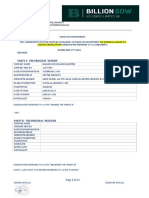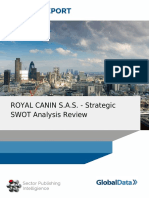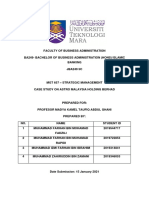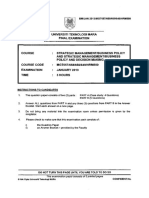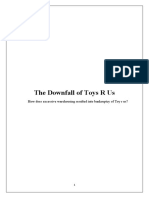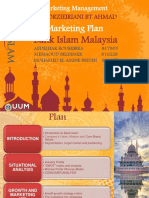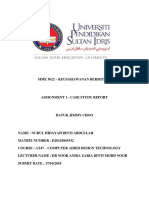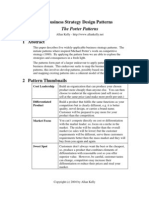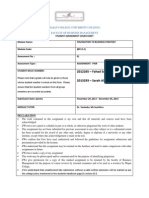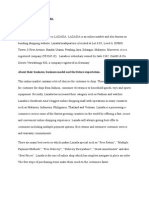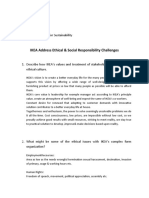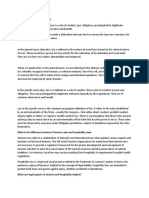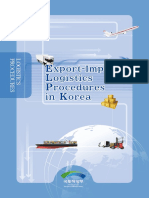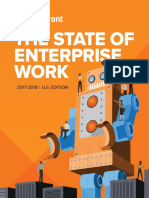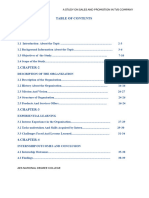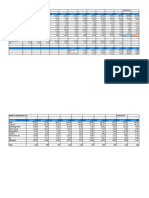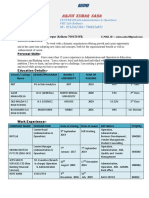Toys R Us Assignment
Toys R Us Assignment
Uploaded by
hussamahmad24Copyright:
Available Formats
Toys R Us Assignment
Toys R Us Assignment
Uploaded by
hussamahmad24Original Title
Copyright
Available Formats
Share this document
Did you find this document useful?
Is this content inappropriate?
Copyright:
Available Formats
Toys R Us Assignment
Toys R Us Assignment
Uploaded by
hussamahmad24Copyright:
Available Formats
Toys R Us Case Study Assignment
Joana Pinheiro Portugal Syalisha Latifah Australia
Due: Wednesday, 18 July 2012
Toys R Us which was first introduced as toy supermarket was first founded in the late 1940 by the US businessman, Charles Lazarus. As the worlds leading toy retailers, Toys R Us now operates 875 stores in the United States and Puerto Rico, and more than 625 international stores and over 140 licensed stores in 35 countries and jurisdictions (Toys R Us, 2012).
Within this case study, the problems in transferring the Toys R Us competitive advantages to a foreign market will be identified. As well as the reason behind why did Toys R Us internalize the firm-specific advantages rather than licence another retailer abroad.
Firstly, in order to maintain the top competitive rankings as the worlds leading toy retailers, many retailers discover their unique competitive advantage that differentiates their brand from any similar organizations. By doing this, it is believed that the company will differentiate their firm and avoids engaging in price wars with any other competitors.
Firm competitive advantages is the fundamental aim of business strategy. A competitive advantage is defined as an advantage over competitors gained by offering consumers greater value, either by means of lower prices or by providing grater benefits and service that justifies higher prices (Johansson, 2009).
First of all, Toys R Us has done the expansion from the US market and entered Japan market in 1991. As the largest toy retailers in United States, Toys R Us has developed a strong competitive advantage in the US that is based on fulfilling 95% of consumers needs relating to children and the worlds largest dedicated toy store showcases spectacular attractions and a unique toy shopping experience (Toys R Us, 2012). Toys R Us also has a very well known reputation of a large-size retail space.
On the other hand, Japan has a quite smaller scale retailers. This will be a problem for Toys R Us in transferring their competitive advantages to a foreign market, because as a company whose operational core is mainly in retailing, the Toys R Us has no manufacturing capabilities and relies its business to the suppliers/manufacturers. However, the problems with the entrance in Japan market lies on their incapability to get the necessary permission and empty space needed to open huge stores. The major manufacturers also would not willing to enter into direct deals with Toys R Us, instead preferring to work with the local retailers (Johansson, 2009).
Lastly, the reason why Toys R Us choose to internalize the firm specific advantages rather than licence another retailer is because by doing this way, Toys R Us did not have to train any new employees. As well as saving extra time and money in a new market research they also managed to protect their business and following their own managerial style instead of using Japanese style of doing business.
Reference list
Johansson, J. K. (2009). Global Marketing fifth edition. New York: Mc Graw Hill.
Toys R Us. (2012). About Us. Retreived July 17, 2012, from http://www.toysrusinc.com/about-us/
You might also like
- DOA - 685Q - BILLION SOW - MAY 17th, 2023Document24 pagesDOA - 685Q - BILLION SOW - MAY 17th, 2023Stephen Spilberg100% (1)
- Royal Canin Swot Analysis ReportDocument7 pagesRoyal Canin Swot Analysis ReportSuryaNo ratings yet
- Report of Zynga Inc.Document17 pagesReport of Zynga Inc.Syeda Ayesha ShahrinaNo ratings yet
- Strtategic Management FINALDocument14 pagesStrtategic Management FINALHubert Ho100% (1)
- 5 Foreign Exchange MarketDocument40 pages5 Foreign Exchange MarketRicha ChauhanNo ratings yet
- ASTRO MALAYSIA HOLDING BERHAD - Company Report MGT657 JBA249 5CDocument54 pagesASTRO MALAYSIA HOLDING BERHAD - Company Report MGT657 JBA249 5CLuqmanulhakim JohariNo ratings yet
- Maybank: Organisational Transformation Through Human ResourcesDocument20 pagesMaybank: Organisational Transformation Through Human ResourcesHridaya Ramanarayanan100% (1)
- Swot Analsis For Toys R Us PunitaDocument6 pagesSwot Analsis For Toys R Us PunitaKalpesh PanchalNo ratings yet
- Family MartDocument1 pageFamily MartPrevitha Vitha100% (1)
- Mattel and The Toy Recalls FinalDocument25 pagesMattel and The Toy Recalls FinalSimon Pollard100% (3)
- Walmart's Global Strategies CaseDocument9 pagesWalmart's Global Strategies CaseRandolph LeroyNo ratings yet
- Jimmy ChooDocument3 pagesJimmy ChooSarsikala DhivagarNo ratings yet
- Weaknesses and RecommendationDocument2 pagesWeaknesses and RecommendationEdison Yap Suen Chee75% (4)
- Padini Assignment-1Document16 pagesPadini Assignment-1Nana Shahhh0% (1)
- MGT657 Jan2013 PDFDocument5 pagesMGT657 Jan2013 PDFAthirah Hassan0% (1)
- Presentation MGTDocument14 pagesPresentation MGTnur_azian_6No ratings yet
- Padini SWOTDocument3 pagesPadini SWOTyijinlee80% (5)
- Space Matrix MaybankDocument3 pagesSpace Matrix Maybankrizalstarz100% (15)
- BBPS4103Document12 pagesBBPS4103Ervana Yahya100% (1)
- The Downfall of Toys R UsDocument20 pagesThe Downfall of Toys R UsRitesh JainNo ratings yet
- Deloitte VC Successful PitchDocument53 pagesDeloitte VC Successful PitchStartup Tool Kit100% (2)
- Audit Report Format For Non CaroDocument2 pagesAudit Report Format For Non CaroRohit Agrawal67% (3)
- CaseAnalysis TRU S G GDocument17 pagesCaseAnalysis TRU S G GGovinda Kumar ManwaniNo ratings yet
- Marketing Plan: Bank Islam MalaysiaDocument42 pagesMarketing Plan: Bank Islam MalaysiaFaidz FuadNo ratings yet
- Corporate StrategyDocument11 pagesCorporate StrategyXi Chen0% (1)
- Competitive Analysis of Godrej With SamsungDocument49 pagesCompetitive Analysis of Godrej With SamsungPrem NautiyalNo ratings yet
- Sime Darby Berhad Full AnalysisDocument7 pagesSime Darby Berhad Full AnalysisHari Dass100% (2)
- Retail Toys R UsDocument18 pagesRetail Toys R Usmandar101No ratings yet
- Jimmy ChooDocument7 pagesJimmy ChooFatihah Onn100% (1)
- APOLLO FOOD HOLDINGS. Dividend PolicyDocument21 pagesAPOLLO FOOD HOLDINGS. Dividend PolicyYumi May100% (1)
- Nestle (Malaysia) BHD - Financial AnalysisDocument20 pagesNestle (Malaysia) BHD - Financial AnalysisDavis MaxNo ratings yet
- Thesis Research MethodDocument4 pagesThesis Research MethodBagus Tribawa0% (2)
- Toys R Us ltd1Document8 pagesToys R Us ltd1Thomas LiuNo ratings yet
- PadiniDocument22 pagesPadinizephyryu100% (1)
- Proton Marketing StrategyDocument3 pagesProton Marketing StrategyNadiah AzizNo ratings yet
- Samsung Company MGT162Document13 pagesSamsung Company MGT162Khadijah HameedNo ratings yet
- Global Marketing Case Study Tesco Expansion FailureDocument9 pagesGlobal Marketing Case Study Tesco Expansion FailureLưu LyNo ratings yet
- Case Study Ethical Dilemmas 2Document8 pagesCase Study Ethical Dilemmas 2AsiiyahNo ratings yet
- Corporate Failure (Assignment)Document9 pagesCorporate Failure (Assignment)Talha MunirNo ratings yet
- MGT657 - Group Wind - Company Business ReviewDocument27 pagesMGT657 - Group Wind - Company Business Reviewizzat asriNo ratings yet
- The Porter Patterns - Business Strategy Design PatternsDocument26 pagesThe Porter Patterns - Business Strategy Design PatternsInformation should be FREENo ratings yet
- External Forces: (CITATION Ast12 /L 17417)Document3 pagesExternal Forces: (CITATION Ast12 /L 17417)Siti NabilahNo ratings yet
- Research Paper-TescoDocument29 pagesResearch Paper-TescohariNo ratings yet
- Assignment Mkt243-Localit Bakery (Final)Document25 pagesAssignment Mkt243-Localit Bakery (Final)Muhammad RidhuanNo ratings yet
- Law AssignmentDocument14 pagesLaw AssignmentLiyaana Ahmad100% (1)
- IKEA Offers A Wide Range of Well-Designed, Functional Home Furnishing Products atDocument25 pagesIKEA Offers A Wide Range of Well-Designed, Functional Home Furnishing Products atSana Naeem67% (3)
- Background of The Case Selected HOW What WHO When WHYDocument12 pagesBackground of The Case Selected HOW What WHO When WHYRahimah NuryatiNo ratings yet
- Case 5 Proton Full AssignmentDocument33 pagesCase 5 Proton Full Assignmentnajihah radziNo ratings yet
- Pestle Analysis OnDocument11 pagesPestle Analysis OnSagarNo ratings yet
- Ioi Group BackgroundDocument1 pageIoi Group Backgroundscribdoobidoo100% (1)
- Individual Case Assgmt 1-PBB Group Berhad 2022Document3 pagesIndividual Case Assgmt 1-PBB Group Berhad 2022Nur Aina SyazanaNo ratings yet
- Affecting Makerting Performance of Proton Car in Malaysia Marketing EssayDocument24 pagesAffecting Makerting Performance of Proton Car in Malaysia Marketing EssayDedalu Selalu33% (3)
- From Low Cost To Global LeadershipDocument14 pagesFrom Low Cost To Global LeadershipTanu Lahoti100% (1)
- Strategic Audit Google IncDocument12 pagesStrategic Audit Google IncAlfonsus Roni Hartono0% (1)
- Strategic ManagementDocument34 pagesStrategic ManagementAnimalaRamachandran100% (2)
- Strategic Management: 71340 Assignment 3, Prepared by Ansell, Ruth Marie Student ID 4201600Document20 pagesStrategic Management: 71340 Assignment 3, Prepared by Ansell, Ruth Marie Student ID 4201600Ruth AnsellNo ratings yet
- HRM648-Group Report Asgmt 3 - Oct2020Document1 pageHRM648-Group Report Asgmt 3 - Oct2020ayen naimNo ratings yet
- LAZADA - EcommerceDocument4 pagesLAZADA - EcommerceMc Řäĵ67% (3)
- Comparison Between Nike and AdidasDocument14 pagesComparison Between Nike and AdidasSombis2011No ratings yet
- IKEA Address Ethical & Social Responsibility ChallengesDocument2 pagesIKEA Address Ethical & Social Responsibility ChallengesPratiksha Gaikwad75% (4)
- Background of MameeDocument1 pageBackground of MameeGoh Chia Fung60% (5)
- Toys "R" Us, Inc. Is The World's Leading Dedicated Toy and Juvenile Products Retailer, Offering ADocument6 pagesToys "R" Us, Inc. Is The World's Leading Dedicated Toy and Juvenile Products Retailer, Offering Aakak00No ratings yet
- Ch3 Toys R UsDocument2 pagesCh3 Toys R UsfrankmarsonNo ratings yet
- Individual Assignment 1 - 0332273Document7 pagesIndividual Assignment 1 - 0332273Rishi TenaNo ratings yet
- Analisis Perencanaan Supply Chain Management (SCM) Pada Produksi Minuman Sari Buah Ukm LarasatiDocument12 pagesAnalisis Perencanaan Supply Chain Management (SCM) Pada Produksi Minuman Sari Buah Ukm LarasatiHanin FitriaNo ratings yet
- Tourism and Hospitality LawDocument4 pagesTourism and Hospitality LawSarah Mae AlcazarenNo ratings yet
- Csi-Scm 1Document12 pagesCsi-Scm 1danijel_stanojevic_1No ratings yet
- Quality of Work Life: Presented and Submitted by K.Hemasri 19L31E0116Document15 pagesQuality of Work Life: Presented and Submitted by K.Hemasri 19L31E0116Hemasri ChinnuNo ratings yet
- Civil Engineer Resume 3Document2 pagesCivil Engineer Resume 3Nazee 122333No ratings yet
- Export-Import Logistics Process in Korea 1st PDFDocument17 pagesExport-Import Logistics Process in Korea 1st PDFNurul May ApriyaniNo ratings yet
- 2017 2018 State of Enterprise Work Report U S Edition PDFDocument36 pages2017 2018 State of Enterprise Work Report U S Edition PDFracrabeNo ratings yet
- Social Security Contribution LevyDocument5 pagesSocial Security Contribution LevyNews CutterNo ratings yet
- AGRICULTURE Notes Revision Nov ExamDocument4 pagesAGRICULTURE Notes Revision Nov ExamcgmaliaNo ratings yet
- Law MergedDocument165 pagesLaw MergedRengeline LucasNo ratings yet
- Derivatives and Foreign Currency Transactions Joint VentureDocument3 pagesDerivatives and Foreign Currency Transactions Joint VentureVincent Larrie MoldezNo ratings yet
- HSL Logistics India PVT LTDDocument8 pagesHSL Logistics India PVT LTDnagarajtakraw14No ratings yet
- BHARATH AutooooDocument43 pagesBHARATH AutooooShashi ReddyNo ratings yet
- Birla Sun Life Insurance CompanyDocument13 pagesBirla Sun Life Insurance CompanyGurleen Singh AroraNo ratings yet
- Motorcycles IranDocument2 pagesMotorcycles IransadullahNo ratings yet
- PI KIT 2024 Ignicion MentorshipDocument176 pagesPI KIT 2024 Ignicion MentorshipNIRAJ KUMAR YADAVNo ratings yet
- Green Consumerism An Eco-Friendly Behaviour Form TDocument5 pagesGreen Consumerism An Eco-Friendly Behaviour Form Tsreekutty A SNo ratings yet
- Logistic and SCM in MahindraDocument59 pagesLogistic and SCM in MahindraKinjal KunjaNo ratings yet
- PoM Ch5Document47 pagesPoM Ch5Nikola DraskovicNo ratings yet
- Duterte-Style Populism: The Philippines in The Geopolitical Economy of Southeast Asia, 22.11.2016Document38 pagesDuterte-Style Populism: The Philippines in The Geopolitical Economy of Southeast Asia, 22.11.2016bonnjuego100% (1)
- Borosil RenewDocument10 pagesBorosil RenewSahil DagarNo ratings yet
- R25 Financial Reporting Quality IFT NotesDocument20 pagesR25 Financial Reporting Quality IFT Notesmd mehmoodNo ratings yet
- Tutorial 6 Suggested SolutionsDocument7 pagesTutorial 6 Suggested Solutionsrais husseinNo ratings yet
- Arjun Kumar Saha: CENTER HEAD (Administration & Operation) NIIT LTD (Kolkata)Document5 pagesArjun Kumar Saha: CENTER HEAD (Administration & Operation) NIIT LTD (Kolkata)HRD CORP CONSULTANCYNo ratings yet
- Geography (Mains) Previous 33 Years Question Papers (1979-2011) by (WWW - Mrunal.org) For UPSC IAS IPS ExamDocument51 pagesGeography (Mains) Previous 33 Years Question Papers (1979-2011) by (WWW - Mrunal.org) For UPSC IAS IPS Examajaybisht42% (12)
- Socialized Housing:: Focusing On The Issues and Offering SolutionsDocument33 pagesSocialized Housing:: Focusing On The Issues and Offering SolutionsKathleen Kaye DialNo ratings yet
